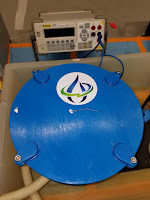If you follow BioLargo Water and its Advanced
Oxidation System, you may sometimes wonder how exactly it functions – ie how
does it actually treat water? You have probably seen our short descriptions of
its function: that it generates highly reactive iodine molecules at its
electrodes, resulting in disinfection and decontamination, but the truth is A)
this is an oversimplification and B) you may not be entirely clear on what this
means!
To expand on this simplified explanation: in the AOS there
are two modes of actions by which it treats water. One is the oxidation – the
chemical action of removing electrons - of proteins inside bacteria passing
through the AOS, resulting in inactivation or killing of those bacteria. The
second mode of action is the breaking down of pollutants by oxidation, that is
to say the structural or chemical alteration of chemical pollutants by the
process of oxidation.
 |
| A peak at an AOS Spiral Reactor |
Understanding these modes of action is crucial to
BioLargo from a technical AND business perspective. Why? Because by having a
solid understanding of how the AOS works on a fundamental molecular level, we
can optimize and modify the AOS to maximize its water treatment potential
without causing it to consume more electricity or consumables – both of which translate
to money ($$$)!
We’re happy to say that BioLargo Water, our water
treatment subsidiary, has been awarded $50,000 CAD last week by the National
Science and Engineering Research Council of Canada (NSERC) to investigate,
using cutting-edge analytical tools, the mechanism of complete breakdown of
harmful compounds by the AOS (discussed further in this article).
Congratulations to BioLargo Water!
Wastewaters can be treated by a huge variety of
techniques. In recent years, electrochemical treatment has become of high interest
to the water treatment industry given its ability to provide simultaneous
disinfection and oxidation/reduction of chemical compounds – this is why we
invented the AOS. Electrochemical treatment has shown disinfection capabilities
for a variety of waters and good performance for both disinfection and decontamination.
The advantages of the AOS include its ability to treat wastewaters cost- and
energy-efficiently, at ambient temperature and pressure, its requirement for
minimal chemical addition, and its low solid waste production. However, any
advanced oxidation technique has the potential to generate by-products (BPs)
while breaking down harmful organics. It is of high importance, therefore, to evaluate
the AOS for the possible generation of of by-products (BPs) – it’s essentially
a necessary step for an electrochemical water treatment system.
 |
| Dr. Susana Kimura-Hara |
Dr. Susana Kimura-Hara at the
University of Calgary is our lead academic partner in this project. She will
use her unique expertise in analytical chemistry, specifically in the field of
identification and formation mechanisms of unregulated disinfection by-products,
and will be using state-of-the-art techniques and instrumentations that are not
otherwise available to BioLargo Water. This project will empower BioLargo Water
to accelerate the commercialization of the AOS technology with assurances of the
safety of its effluent.

No comments:
Post a Comment